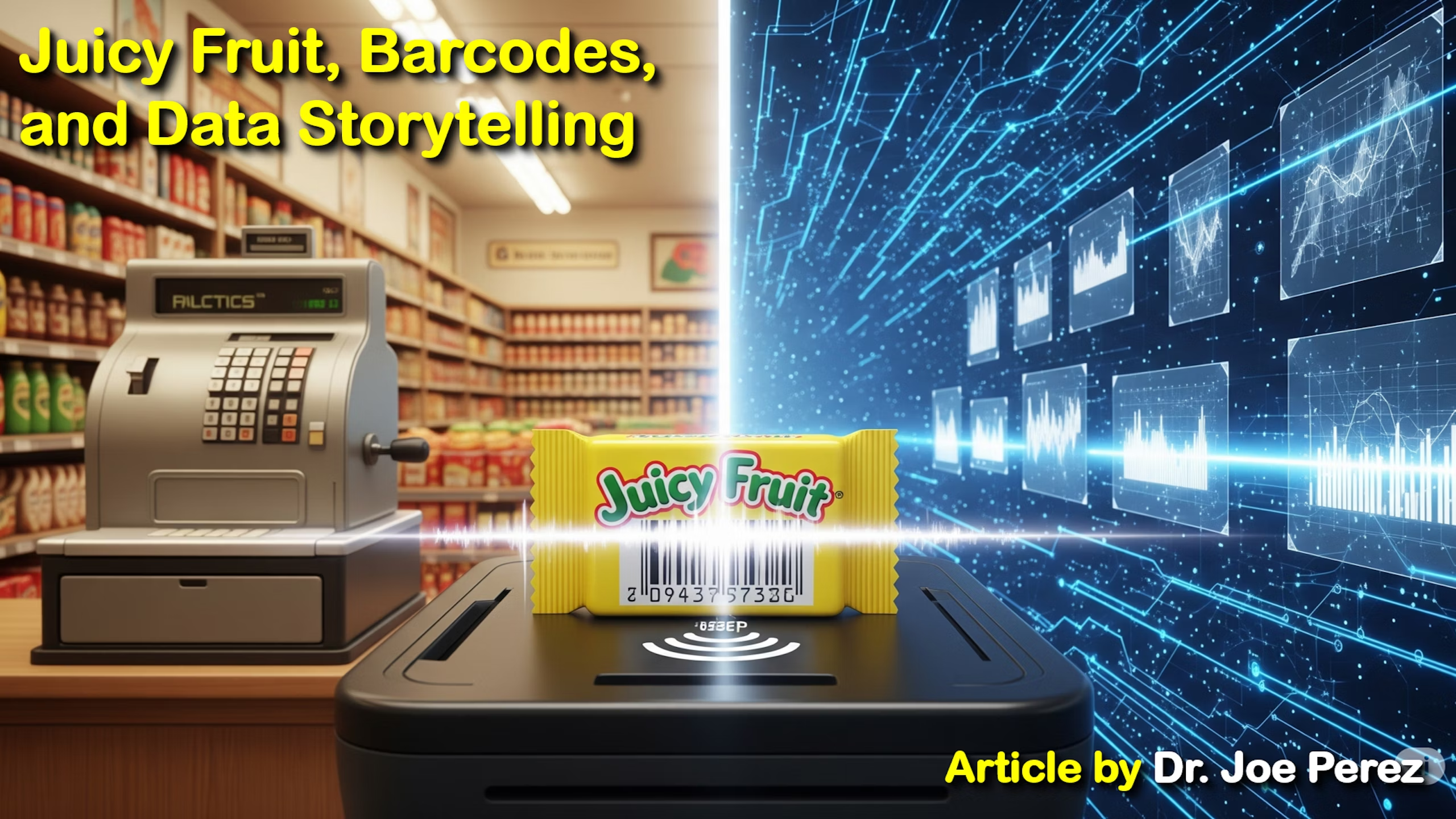
Juicy Fruit Gum, the First Barcode & Data Storytelling

On the morning of June 26, 1974, at a small supermarket in Troy, Ohio, a 10-pack of Juicy Fruit gum was the very first retail item in history to be scanned with a barcode. Cashier Sharon Buchanan anxiously waited as the scanner whirred, and then, with a sharp, electronic “beep,” history had been made. Her relief was shared by colleagues who had spent the night sticking codes onto items and wiring up the supermarket’s brand-new system. The “customer” wasn’t a shopper at all, but Clyde Dawson, head of research and development for Marsh Supermarkets. He deliberately chose the gum, fearing its tiny barcode might be too small for the machine to read. But it scanned flawlessly.
That humble moment (a piece of gum, a nervous cashier, and an expectant researcher) unlocked a revolution in commerce, logistics, and global efficiency. Yet the story didn’t begin there. Twenty-five years earlier, in 1949, a young engineer named N. Joseph Woodland drew the first design for a barcode in the Miami Beach sand. Inspired by a conversation with Bernard “Bob” Silver about a supermarket manager’s frustrations with long checkout lines, Woodland envisioned a bullseye-shaped code. They patented the design in 1952 but lacked the technology to make it usable. The laser hadn’t yet been invented, scanners were impractically large, and so they sold the patent for a mere $15,000. Years later, Woodland joined IBM, and in 1973, his colleague George Laurer refined the idea into the rectangular barcode we know today, paving the way for billions of scans daily.
What makes a tale of gum and grocery lines so interesting? This is a story of perseverance and the joy of discovery; it includes the sort of surprising turn that makes data storytelling so effective. Much like that first beep at the Marsh Supermarket in 1974, the best stories go beyond simply informing the listener. They surprise us, shift our perspective, and reveal doors we didn’t know existed.
In this article, I’d like to apply this barcode story with four dimensions of discovery in data storytelling. To make these dimensions easier to remember, I’ve boiled each of them down to a rhyming keyword: Spark, Mark, Arc, and Remark. The goal is for you to see the rhythm they form, not unlike the cadence of a well-told story or, if you will, the beeping of a scanner in a busy supermarket.
Spark: The Ignition of Curiosity
Every story begins with a spark; a moment when curiosity and possibility collide with each other. With Woodland, it was the everyday scratch of circles in the earth, a fleeting thought born from a modest issue: shopping queues crawled too slowly. That curiosity drove innovation, although the process of turning that innovation into reality took decades.
In data storytelling, the catalyst (or “spark”) is usually a question that doesn’t fit the current story. Why are certain customers dropping off at one stage of a journey? Why is a particular region underperforming despite strong macroeconomic conditions? Why does one variable refuse to align with the expected pattern?
The joy here lies in chasing those sparks instead of dismissing them. Too often, we’re trained to force-fit data into the story we expect, but the sparks usually live in the anomalies; that is, the blips, the outliers, the data points that seem almost “too small to matter,” like the barcode on a stick of gum. And yet, just as that gum packet became the symbol of a global technological leap, the smallest sparks in data can set off revolutions in insight.
Mark: The Imprint of Context
A barcode by itself is nothing more than just a series of lines. You don’t see that barcode’s real value until it’s paired up with a system that can read, interpret, and act upon it. Stated in a different way, the barcode is a mark; a symbol that gains meaning through context.
Data storytelling works the same way. Numbers without context are like lines without scanners. When we give data a mark (i.e., an imprint of relevance tied to human experience), it transforms from abstraction into narrative.
Consider unemployment data. To say that unemployment dropped from 6% to 5% is to state a number. But to mark that decline with a story, like a factory reopening, a family returning to stability, a community regaining momentum, etc., is to breathe life into the numbers. The “mark” roots the abstract into reality.
And here’s the deeper joy: the act of marking data with context forces us to see its connections. Just as the barcode connected a product on a shelf to an entire global supply chain, good data storytelling connects numbers to human stories. It imprints them with meaning.
Arc: The Shape of Transformation
Great stories, whether in literature or data, have an arc; that is, a trajectory that takes us from beginning to end with transformation in between. The barcode story has its arc: from circles drawn in the sand, to a failed bullseye design, to a flawless beep in a supermarket, to billions of daily scans.
When telling stories with data, we often forget the importance of that arc. We present static snapshots (i.e., charts, tables, single points in time) without carrying the audience through the transformation those numbers reveal. But it’s the arc that gives data its power: not what the numbers are, but what they become.
For example, showing that a company reduced waste by 20 percent in a year is informative. But showing the arc (for example: how failed initiatives in year one laid the foundation for breakthroughs in year two, and how those breakthroughs cascaded into unexpected efficiencies in year three), now THAT is transformative. That’s what moves an audience.
And arcs aren’t always predictable. Just as Woodland’s design had to wait for the invention of the laser, sometimes data arcs unfold over decades. As storytellers, our role is to reveal those shapes of transformation, even when they defy neat linearity.
Remark: The Echo That Stays
Finally, there’s the remark; the lasting impression. Sharon Buchanan likely didn’t think she was making history when she scanned that gum, but the “beep” became a cultural echo, reverberating across industries and generations.
In data storytelling, the remark is the insight or image that stays with the audience long after the presentation ends. It’s not the table of statistics or the regression model that people remember; it’s the single line that crystallizes the meaning, the metaphor that sharpens the abstract into the tangible.
The joy of discovery here is in crafting remarks that stick. Think of the barcode itself: simple, efficient, universal. A line of black and white, endlessly repeated, carrying infinite variation. That’s the essence of a great remark: compact, repeatable, resonant.
Conclusion: The Joy of the Unexpected
What makes the Juicy Fruit story so powerful is that nobody expected gum to become the symbol of a technological revolution. And yet, there it was, carrying a tiny code that spoke volumes.
In data storytelling, joy arises when we lean into the unexpected. When we allow curiosity to spark, when we mark data with context, when we shape arcs of transformation, and when we leave lasting remarks, we go way beyond presenting numbers. We create discovery.
And here’s the twist, the part that I suspect would make even Woodland smile: every barcode has lines, but no two sets of lines are exactly the same. They look simple, almost boring, until you realize they represent an entire world behind them. Data is like that, too. At first glance, it’s just lines, numbers, black and white. But with the right lens, with Spark, Mark, Arc, and Remark, it comes alive.
So the next time you hear the beep of a scanner, think of Juicy Fruit gum, a nervous cashier, and a researcher holding his breath. And then remember: the joy of discovery is not in the numbers themselves. It’s in the unexpected stories hiding between the lines.

 - by
- by







